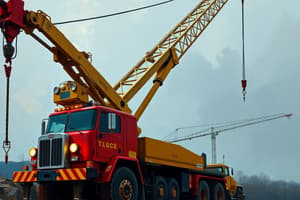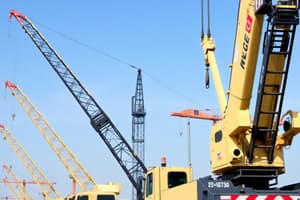Podcast
Questions and Answers
What are cranes primarily used for in construction and other industries?
What are cranes primarily used for in construction and other industries?
- Assembly of construction tools
- Moving various materials (correct)
- Transporting workers to heights
- Cleaning debris from construction sites
Which type of crane is known for its ability to reach great heights with a tall arm?
Which type of crane is known for its ability to reach great heights with a tall arm?
- Overhead cranes
- Mobile cranes
- Tower cranes (correct)
- Floating cranes
What type of crane is mounted on wheels or crawlers for enhanced mobility around job sites?
What type of crane is mounted on wheels or crawlers for enhanced mobility around job sites?
- Tower cranes
- Mobile cranes (correct)
- Overhead cranes
- Floating cranes
Why are counterweights used in crane operations?
Why are counterweights used in crane operations?
Where are overhead cranes commonly found for moving goods?
Where are overhead cranes commonly found for moving goods?
______ have been around since ancient times and were used by humans from early civilizations to move heavy objects.
______ have been around since ancient times and were used by humans from early civilizations to move heavy objects.
Crane technology has evolved over time, but the basic principles remain the same—lifting power sources and hydraulic systems make it possible to raise and lower cargo using ______ and pulleys.
Crane technology has evolved over time, but the basic principles remain the same—lifting power sources and hydraulic systems make it possible to raise and lower cargo using ______ and pulleys.
The first cranes appeared during the ______ period, where they were known as 'tower cranes'.
The first cranes appeared during the ______ period, where they were known as 'tower cranes'.
______ cranes are mounted on wheeled carthorse chassis and are capable of moving short distances between operations.
______ cranes are mounted on wheeled carthorse chassis and are capable of moving short distances between operations.
______ cranes work on barges and tower cranes operate from a fixed point on land.
______ cranes work on barges and tower cranes operate from a fixed point on land.
Flashcards are hidden until you start studying
Study Notes
Cranes are large, heavy machines used in construction and other industries for lifting, lowering, and moving various materials, such as steel girders, concrete slabs, and shipping containers. They come in different types, including tower cranes, mobile cranes, floating cranes, and overhead cranes, each designed for specific purposes. These machines work using counterweights, which balance the load and help stabilize the operation.
Tower cranes, also known as city cranes or high rise cranes, are tall structures with an arm that can reach great heights. They're typically set up on construction sites and remain there throughout the duration of a project. Mobile cranes are mounted on wheels or crawlers, making them more versatile and able to move around job sites easily. Floating cranes are essentially barges fitted with massive crane booms that lift entire vessels out of the water for maintenance or scrapping. Overhead cranes are found in places like warehouses and manufacturing facilities where they're used for moving goods within enclosed areas.
The earliest recorded crane was invented by Heron of Alexandria during the Roman Empire, who built a steam-powered hoist for the Temple of Serapis in Rome. Modern cranes have evolved significantly since then, incorporating hydraulic power and computer control systems. Operators guide these machines remotely from cabins or ground controls, ensuring safety and precision when handling loads.
Cranes play a vital role in building cities, bridges, roads, and other infrastructure projects, greatly speeding up progress and reducing labor costs. However, accidents involving cranes do occur occasionally due to factors such as operator error, mechanical failure, poor weather conditions, or improper setup. In response, strict regulations govern their use and regular inspections ensure their safe operation.
In conclusion, cranes are essential tools in modern industry, allowing us to build skyscrapers, transport cargo, and complete many tasks that would otherwise be impossible. Their design and evolution reflect our human ingenuity, pushing the boundaries of what we can achieve with technology.
Studying That Suits You
Use AI to generate personalized quizzes and flashcards to suit your learning preferences.




